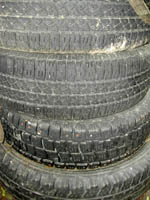Contact Pacific Southwest Waste Program
Pacific Southwest, Region 9
Serving: Arizona, California, Hawaii, Nevada, Pacific Islands, Tribal Nations
Scrap Tires in Region 9
National Links
Every year, the states in Region 9 face the task of managing millions of scrap tires generated by a growing population that relies on vehicles as the most popular means of transportation. Fortunately, markets now exist for the majority of these scrap tires. Region 9 supports the production and use of crumb rubber in new molded rubber products, the use of rubberized asphalt concrete on roadways, the use of waste tires in civil engineering applications, and the use of tire-derived fuel in manufacturing and energy production. Through these innovative uses of scrap tires, markets for scrap tire material continue to grow throughout Region 9. The remaining scrap tires are still stockpiled or landfilled.
Region 9 is also actively involved in addressing scrap tire management along the U.S./Mexico border.
Scrap Tires Along the US/Mexico Border

Waste tire piles are a significant environmental concern on the border. Region 9 is currently working with private industry, the state of California, Mexico's Secretariat of Environment and Natural Resources (Secretaría del Medio Ambiente y Recursos Naturales, SEMARNAT), and various contributors to the Border 2012 plan to find the best solutions for the tire pile problem along the border. Addressing this problem is one of the objectives laid out in the U.S.-Mexico Border 2012 plan. The largest tire pile is located at Cerro Centinela, near Mexicali, Baja, California and contains approximately 1 million tires. In the US, markets now exist for 78% of the 281 million scrap tires generated each year. This strong market is due in part to the work done by California and other states to find many innovative and beneficial uses for scrap tires. EPA Region 9 is committed to addressing the problem of waste tire piles and to finding feasible solutions to the dangerous scrap tire issue along the border.
There are many potential end uses for waste tires, including rubberized asphalt applications, playground surfacing and roadside sound wall barrier construction. Other feasible uses for scrap tires along the border include tire-derived fuel and civil engineering applications. Region 9 is currently researching the feasibility and opportunities for developing tire recycling initiatives in border communities to provide scrap tires for innovative projects. We are also researching the destruction of waste tires in existing cement kilns that already accept tires as part of their fuel source. Our goal is to facilitate the cleanup and reuse of three of the largest tire piles in the border region.
